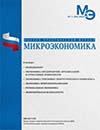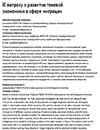On the development of the shadow economy in the field of migration
The article is devoted to the study of the problems of illegal migration and the use of migrant labor in the shadow sector of the economy. The author’s division of all labor migrants into three groups is given, according to income level, social status and specifics of the performed works. A large list of different sources consisting of statistical data, analytical reviews, scientific texts and journal articles has been studied. The dependence of poor sectors of the economy on cheap labor provided by labor migrants and, at the same time, the gradual and steady displacement of indigenous local residents by foreign workers in the labor market is shown. The authors come to the conclusion that it is impossible to build an economically developed state and a humane civilized society without solving the problems of illegal migration and its attendant shadow economy.
References:
|
1. Popkova E. Types of labor migration in Russia. 2019. [Electronic resource.] – Mode of access: https://migrantvisa.ru/russia/migraciya/trudovaja/ (date accessed: 05.08.2019). 2. Strategies of national security of the Russian Federation [Electronic resource]: decree of the President of the Russian Federation of 31.12.2015 No. 683. – Access from the legal reference system «ConsultantPlus». 3. Golikova T. A. Russia is losing its population catastrophically. 2019. [Electronic resource.] – Mode of access: https://www.vesti.ru/doc.html?id=3164090 (date accessed: 05.08.2019). 4. The head of Perm said that for the first time in recent years, the city faced a natural decline in population. 2019. 59 RU PERM ONLINE. [Electronic resource.] – Mode of access: https://59.ru/text/gorod/66105787/ (date accessed: 10.07.2019). 5. Statistical data on the migration situation [Electronic resource]. – Mode of access: https://мвд.рф/Deljatelnost/statistics/migracionnaya (date accessed: 06.07.2019). 6. Dyatlov V. I. Migrants and host society: strategies and practices of adaptation (on the example of Irkutsk). 2007. [Electronic resource.] – Mode of access: https://buk.irk.ru/exp_seminar/3/3_dyatlov.pdf (date accessed: 06.08.2019). 7. Kovalenko V. I., Shuraeva L. M., Zhukov P. S. Influence of migration flows on the crime situation. Analytical review. FGKU «research Institute of the Ministry of internal Affairs of Russia». Moscow, 2018. – URL: https://41.мвд.рф/влияние-миграционных-потоков-на-криминог (date accessed: 06.08.2019). 8. Fictitious marriage to obtain Russian citizenship. 2018. MIGRANT TO RUSSIA.RU. [Electronic resource.] – Access mode: https://migrantvrf.ru/grazhdanstvo/fiktivnyj-brak-dlya-polucheniya-rossii-tsena/ (date accessed: 06.08.2019). 9. Marx K. G. Capital. Criticism of political economy. Volume 1. Book 1. The process of capital production [Electronic resource]. – Mode of access: https://esperanto.mv.ru/Marksismo/Kapital1/ (date accessed: 11.09.2019). 10. Grigorichev K. V., Dyatlov V. I. «Chinese» markets of Russia: role in post-socialist transformation (Irkutsk case). Vestnik of Tomsk state University. 2017. № 419. pp. 121. 11. Causes of flooding in the Irkutsk region: why flooded Tulun and Nizhneudinsk. 2019. Komsomolskaya Pravda Irkutsk [Electronic resource]. – Mode of access: https://www.irk.kp.ru/daily/26996.5/4057909/ (date accessed: 11.09.2019). 12. Why do the Chinese in Russia grow tomatoes on banned fertilizers and chemicals? 2015. Agricultural portal AGROXXI [Electronic resource]. – Access mode: https://www.agroxxi.ru/biobezopasnost/pochemu-kitaicy-v-rossii-vyraschivayut-pomidory-na-zapreschennyh-udobrenijah-i-himikatah.html (date accessed 11.09.2019). 13. The unemployment rate in Russia-2019. Statistics. 2019. [Electronic resource.] – Access mode: https://yandex.ru/turbo?text=https%3A%2F%2Fzaimisrochno.ru%2Farticles%2F4114-uroven-bezraboticy-v-rf-2019-statistika. (date accessed 24.09.2019). 14. How China assessed Russian agriculture and Sino-Russian agricultural cooperation. 2015. Agricultural portal AGROXXI [Electronic resource]. – Access mode: https://www.agroxxi.ru/stati/kak-kitai-ocenival-selskoe-hozjaistvo-rossii-i-kitaisko-rossiiskoe-selskohozjaistvennoe-sotrudnichestvo.html (date accessed 11.09.2019). 15. Incomes from labor migrants to the budget of the Kama region increased by 15%. 2019. Rifey-Perm [Electronic resource]. – Mode of access: https://www.rifey.ru/news/perm/show_id_79607/ (date accessed: 24.09.2019). |



